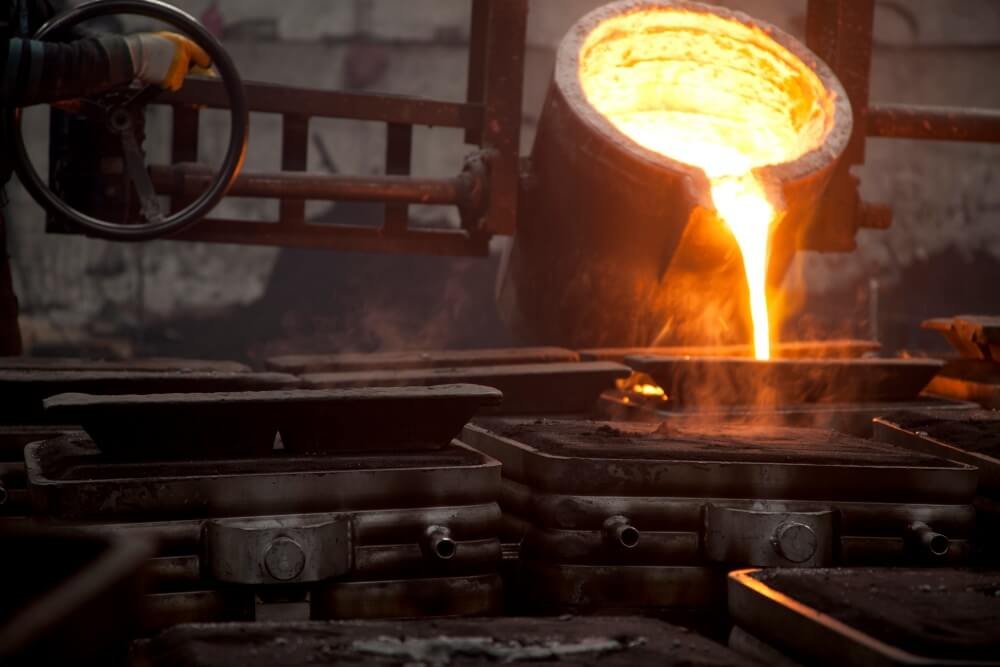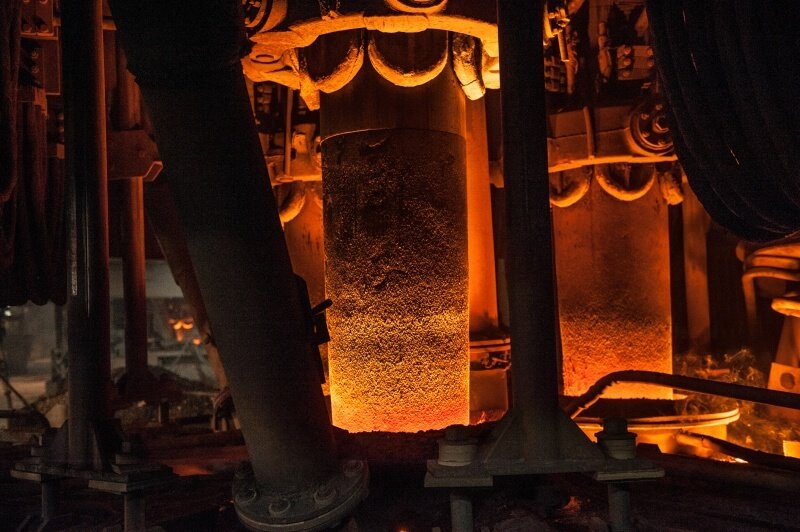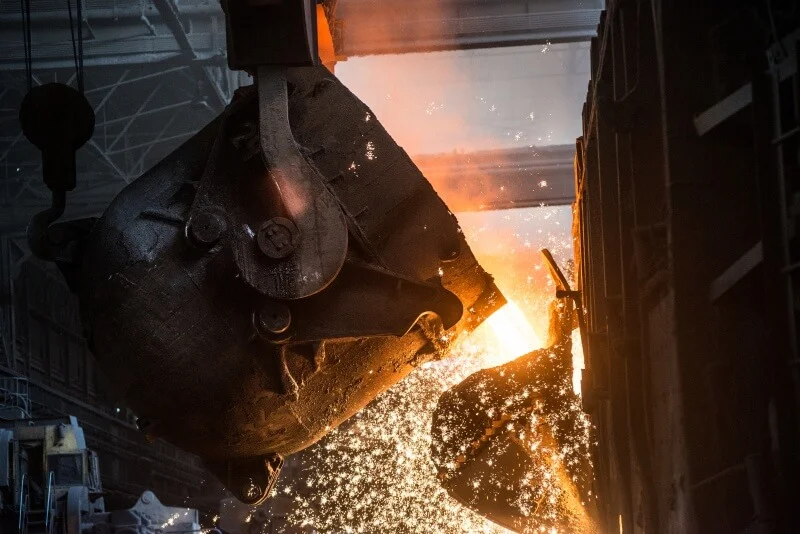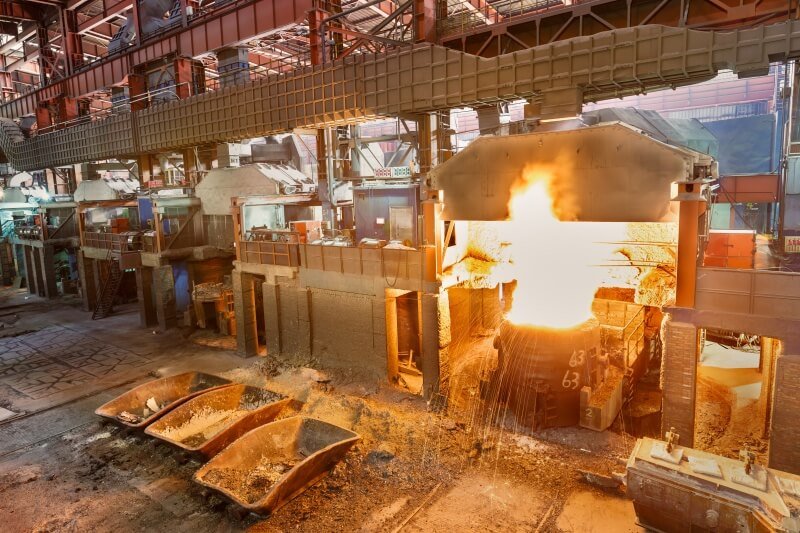Designing a lightweight yet durable cylindrical part often feels like an impossible trade-off. Traditional casting introduces defects such as porosity, while forging, though strong, is prohibitively expensive. The real challenge is balancing structural integrity with cost efficiency for your aluminum components. This guide introduces aluminum centrifugal casting as the superior solution. By using rotational force to produce dense, defect-free parts with minimal material waste, it allows you to achieve both performance and budget goals—delivering high-quality components that stand up to demanding applications without breaking production costs.

1. Understanding Aluminum Centrifugal Casting
This process uses immense rotational pressure to shape molten aluminum into dense, high-integrity cylindrical parts. This method is ideal for components where material soundness is critical. It sets a new standard for performance compared to other casting methods.
The Core Definition
Here’s the deal: it’s a process where molten aluminum is poured into a rotating mold, and centrifugal force shapes the metal. This creates incredibly dense and strong cylindrical parts. The process ensures your components meet demanding specifications.
How Is It Different?
Unlike gravity-fed methods, this process uses immense rotational pressure to eliminate porosity and push impurities inward for later removal.
- Uses centrifugal force, not gravity
- Produces denser material structure
- Forces impurities to the inner diameter for removal
The Origin of This Casting Method
Key Takeaway: Aluminum centrifugal casting is a pressure-based process refined over two centuries to produce exceptionally dense and clean cylindrical parts, setting it apart from other casting methods.
| Milestone | Description |
|---|---|
| 1809 | Initial patent granted in England. |
| Post-WWI | Process perfected for pipe manufacturing. |
| Modern Day | Used for high-performance aerospace & auto parts. |
The table illustrates a century of refinement, leading to today’s high-precision capabilities.
2. How Aluminum Centrifugal Casting Works
The process begins with a pre-heated, rotating mold, which can be oriented horizontally or vertically depending on your part. Molten aluminum is poured in, and rotational speeds of 300-3000 rpm generate immense force. This force presses the metal against the mold walls.
What is the basic setup?
It all starts here: a pre-heated mold spins while molten aluminum is poured inside. Rotational speeds generate G-forces nearly 100 times gravity. This immense pressure ensures the aluminum perfectly conforms to the mold.
The Solidification Process
This is where the magic happens: as the mold spins, the aluminum solidifies from the outside-in under high pressure. This directional cooling prevents defects like shrinkage cavities and gas pockets. The result is a fine-grained, flawless structure for your part.
Key Steps for Your Project
Key Takeaway: The process uses a controlled, high-pressure solidification sequence to create an aluminum part that is structurally superior, dense, and free of common casting defects.
| Step | Purpose |
|---|---|
| 1. Mold Preparation | Coat the mold to protect it and aid solidification. |
| 2. Pouring | Introduce molten aluminum into the rotating mold. |
| 3. Spinning | Use centrifugal force to shape metal and expel impurities. |
| 4. Cooling | Allow the part to solidify under continuous rotation. |
| 5. Extraction | Remove the finished, high-density casting. |
The table shows that each step is designed to maximize density and minimize defects.
3. Types of Aluminum Centrifugal Casting
This versatile process can be adapted based on the geometry of your part. The three primary methods—true, semi-centrifugal, and centrifuging—cater to different shapes and sizes. Understanding these helps you select the right approach for your needs.
True Centrifugal Casting
First up: this is the most common type, used to produce hollow cylindrical parts like pipes, bushings, and rings. The molten aluminum forms a uniform wall thickness against the spinning mold. You’ll find this method is perfect for symmetrical, hollow components.
Semi-Centrifugal Casting
But what if your part isn’t a simple tube? This method is used for solid parts like gear blanks where the outer sections require the highest density. The mold is filled completely, and centrifugal force ensures the extremities are dense.
Understanding Centrifuging
Key Takeaway: You can choose from true, semi-centrifugal, or centrifuging methods depending on whether your aluminum part is hollow, solid, or small and intricate.
- True: Pipes, Bushings
- Semi-Centrifugal: Pulleys, Gear Blanks
- Centrifuging: Jewelry, Small Sleeves
| Casting Type | Best For | Key Feature |
|---|---|---|
| True | Hollow cylinders | Creates a uniform wall thickness. |
| Semi-Centrifugal | Solid, symmetrical parts | Densifies the outer regions. |
| Centrifuging | Small, intricate parts | Fills multiple mold cavities at once. |
As the table highlights, the best method for you depends entirely on the geometry and size of your part.
4. Benefits of Aluminum Centrifugal Casting
This process is engineered to produce parts with superior material integrity and structural soundness. It achieves this by eliminating common casting defects and refining the metal’s grain structure. The result is a stronger, cleaner, and more cost-effective component.
Superior Material Integrity
Here’s the bottom line: the process creates castings that are fully dense and free from defects like gas porosity and shrinkage cavities. This is because impurities are forced to the center and machined away. You get a cleaner, stronger final part every time.
Fine Grain & High Strength
And there’s more: rapid, directional cooling from the mold wall inward produces a fine and uniform grain structure. This significantly improves the mechanical properties of the aluminum. Your parts will have greater tensile strength and durability.
Why It’s So Cost-Effective
Key Takeaway: Aluminum centrifugal casting delivers superior, defect-free parts with enhanced mechanical strength while reducing material waste and overall manufacturing costs.
- Higher density and cleanliness
- Improved mechanical properties
- Reduced material waste and cost
- Fine surface detail reproduction
| Advantage | Engineering Impact |
|---|---|
| High Density | Eliminates porosity and internal voids. |
| Fine Grain Structure | Increases tensile strength and durability. |
| High Yield | Reduces material scrap and lowers per-part cost. |
The table demonstrates that each advantage translates directly into a higher-quality, more cost-effective component for you.
5. Limits of Aluminum Centrifugal Casting
While this method offers significant advantages, it’s important to understand its constraints. Certain geometric limitations and tooling considerations apply. Awareness of these factors helps you plan for secondary processes like machining.
Inner Diameter Inaccuracy
Now for the catch: because less dense impurities are forced to the inner diameter, its dimensions are less precise. You will need to account for a final machining step to achieve the exact bore you require. This is a built-in part of the process.
What shapes are difficult?
You might be wondering: while excellent for cylinders, the true centrifugal process is not suitable for parts with complex internal geometries. The inner bore will always be circular due to the physics of rotation. Non-symmetrical hollow shapes are not possible with this method.
Initial Investment & Scale
Key Takeaway: You should be aware of limitations like inner diameter imprecision and geometric constraints, planning for post-machining to achieve your final specifications.
- Imprecise inner diameter before machining
- Limited to cylindrically symmetric hollow parts
- High initial equipment setup cost
| Limitation | Mitigation Strategy |
|---|---|
| ID Inaccuracy | Plan for a final boring/machining operation. |
| Geometric Constraints | Use for rotationally symmetric parts only. |
| High Initial Cost | Best for production runs to amortize tooling costs. |
This table shows that while limitations exist, you can plan for them with secondary operations like machining.
6. Uses for Aluminum Centrifugal Casting
This process is a cornerstone for manufacturing high-performance components across various demanding sectors. Its ability to produce lightweight yet strong parts makes it invaluable. From aerospace to heavy industry, its applications are widespread.
Aerospace & Automotive Parts
Look to the skies and roads: due to its lightweight and high-strength properties, this method is perfect for aerospace and automotive parts. You’ll find it used for cylinder liners, pistons, and gearbox components. These applications demand the reliability this process provides.
Industrial & Petrochemical
Now, let’s get industrial: this method is used to fabricate furnace tubes and hydraulic wear rings that must withstand harsh environments. The dense, corrosion-resistant structure of centrifugally cast aluminum makes it ideal. Your industrial components will last longer.
Can you use it for my industry?
Key Takeaway: From aerospace to industrial machinery, aluminum centrifugal casting is the go-to process for producing critical, high-performance cylindrical components across many industries.
- Aerospace: Jet engine compressor cases
- Automotive: Cylinder liners
- Industrial: Hydraulic wear rings
- Medical: Custom implants
| Industry | Specific Application |
|---|---|
| Aerospace | Jet Engine Compressor Cases, Rings |
| Automotive | Cylinder Liners, Pistons |
| Industrial | Furnace Tubes, Hydraulic Wear Rings |
| Petrochemical | Pipes, Reaction Vessels |
The table illustrates the process’s versatility, proving its value across a wide range of high-performance sectors.
7. Quality in Aluminum Centrifugal Casting
Quality is the defining characteristic of parts made through this process. High rotational forces naturally refine the metal, producing a dense and pure structure. This intrinsic quality control is a key reason engineers choose this method.
Achieving Full Part Density
It’s all about integrity: the defining quality feature of this process is its ability to produce fully dense castings. The high rotational forces compact the molten aluminum, eliminating voids. You can be confident in the structural soundness of your parts.
How are impurities removed?
Here’s how you get a clean part: the process inherently separates materials by density. Lighter elements like oxides and trapped gas are forced to the inner bore. This allows you to easily machine them away, leaving a pure aluminum structure.
What about surface finish?
Key Takeaway: The quality of aluminum centrifugal castings is defined by full density and high purity, which are natural outcomes of a process that uses centrifugal force to its advantage.
- Density (approaching 100%)
- Absence of porosity and inclusions
- Fine-grained microstructure
- Good outer surface detail
| Quality Feature | Process Cause |
|---|---|
| Full Density | High centrifugal forces compact the metal. |
| High Purity | Impurities are segregated to the ID for removal. |
| Fine Grain Structure | Rapid, directional solidification from the mold wall. |
This table clearly links the superior quality outcomes directly to the fundamental physics of the centrifugal process.
8. Comparing Aluminum Centrifugal Casting
Choosing the right manufacturing process requires comparing alternatives. This method offers a unique balance of cost, quality, and geometric capability. It often provides a superior option to both forging and other casting methods for cylindrical parts.
vs. Forging
Let’s compare: forging produces very strong parts, but it is often much more expensive and less suitable for complex shapes than casting. Aluminum centrifugal casting offers a cost-effective alternative. You can achieve near-forged strength at a lower cost.
vs. Gravity/Sand Casting
What about other casting methods? Sand casting is versatile but often results in porosity and a rougher surface finish. Centrifugal casting provides a denser, cleaner part with superior mechanical properties, avoiding common gravity-fed casting defects.
Is it like investment casting?
Key Takeaway: Aluminum centrifugal casting occupies a unique position, offering a superior balance of cost, quality, and performance for cylindrical parts compared to forging and other casting methods.
- Cost: More affordable than forging.
- Quality: Denser than sand casting.
- Shape: Best for cylinders, unlike investment casting.
| Process | Strength | Cost | Best For |
|---|---|---|---|
| Centrifugal Casting | High | Medium | High-integrity cylinders. |
| Forging | Very High | High | Simple shapes needing max strength. |
| Sand Casting | Low-Medium | Low | Complex shapes where porosity is acceptable. |
The data shows that for cylindrical aluminum parts, centrifugal casting hits a sweet spot of quality, cost, and geometric capability.
9. Tooling for Aluminum Centrifugal Casting
The mold, or die, is the heart of the process and its quality directly impacts your final part. Typically made from steel, iron, or graphite, its durability is key. Proper mold design and preparation are essential for success.
The Importance of the Mold
It all comes down to the mold: its durability is key, as it’s reused many times, making the process economical at scale. The quality of your mold directly impacts the dimensional accuracy and surface finish of your part. This tooling is a critical investment.
Horizontal vs. Vertical Molds
Let’s look at the orientation: horizontal molds are popular for long, thin parts like tubes, while vertical molds are better for shorter, larger-diameter parts. You will choose the orientation based on your part’s length-to-diameter ratio. This ensures even material distribution.
What about mold preparation?
Key Takeaway: Your choice of mold material and orientation is critical, and proper mold preparation with a refractory coating is essential for part quality and tool longevity.
- Mold Material (Steel, Iron)
- Mold Orientation (Horizontal vs. Vertical)
- Refractory Coating Application
| Mold Type | Ideal Part Geometry |
|---|---|
| Horizontal | Long parts with a high length-to-diameter ratio (e.g., pipes). |
| Vertical | Short parts with a low length-to-diameter ratio (e.g., rings). |
| Shaped | Parts with non-circular outer profiles (e.g., hexagonal). |
The table provides a clear guide for selecting the right tooling configuration for your specific aluminum component.
10. Costs of Aluminum Centrifugal Casting
The cost structure for this process is favorable for production runs due to its high material yield and low scrap rate. While there is an initial tooling investment, the per-part cost is highly competitive. Understanding the key cost drivers helps you budget effectively.
What Drives the Final Price?
Let’s talk money: the total cost is influenced by tooling complexity, the specific aluminum alloy used, and the part’s size. However, the process’s high yield and low scrap rate make it very competitive. Your per-part cost decreases significantly with volume.
Is the equipment expensive?
Here’s the initial investment breakdown: the machinery represents a significant upfront cost, but it’s far less than that for investment casting. For ongoing production, the reusable molds make it very economical. This makes it accessible for many manufacturers.
How You Save Money in the Long Run
Key Takeaway: While there is an initial investment, aluminum centrifugal casting proves highly cost-effective through reduced material waste and minimal machining needs, offering excellent long-term value.
- Initial equipment and tooling
- Aluminum alloy price
- Reduced material scrap
- Minimized machining labor
| Cost Factor | Upfront | Per-Part |
|---|---|---|
| Tooling (Mold) | High | Low (amortized) |
| Material Waste | N/A | Low (high yield) |
| Machining | N/A | Low (near-net shape) |
This analysis shows that while upfront costs are a factor, the low per-part cost makes it an economical choice for you at production volumes.
Conclusion
You came here looking for a way to produce high-integrity, lightweight aluminum cylinders without the high costs of forging or the defects of gravity casting. This guide has shown how aluminum centrifugal casting directly solves these problems by delivering dense, pure, and cost-effective components. Now that you understand the process, let our experts help you apply it to your project. Upload your CAD file to our Instant Quoting to get a free, no-obligation quote and see how we can manufacture your high-performance aluminum parts.
We are your partners in advanced manufacturing, turning complex engineering challenges into high-quality, tangible results with speed and precision.
FAQ
Q1: Can I use this for non-circular aluminum parts? No, not with the true centrifugal process. The inner bore will always be circular, but the outer profile can be shaped (e.g., hexagonal or fluted) by the mold.
Q2: How do I know if my part is a good fit? Yes, it’s a great fit if your part is a hollow aluminum cylinder or a rotationally symmetric solid requiring high material density and strength.
Q3: Is the heat resistance of the final part good? Yes, absolutely, provided you choose the right aluminum alloy. The ultimate heat resistance is determined by the material properties of the alloy you select.
Q4: Will I need to do a lot of machining afterward? No, not on the outside. The outer diameter is a near-net shape, but you will always need to machine the inner diameter to remove impurities and achieve final accuracy.
Q5: Can I get a single prototype made this way? Yes, it is possible, but it may not be cost-effective. The main expense is the durable mold, making the process more economical for production runs.




